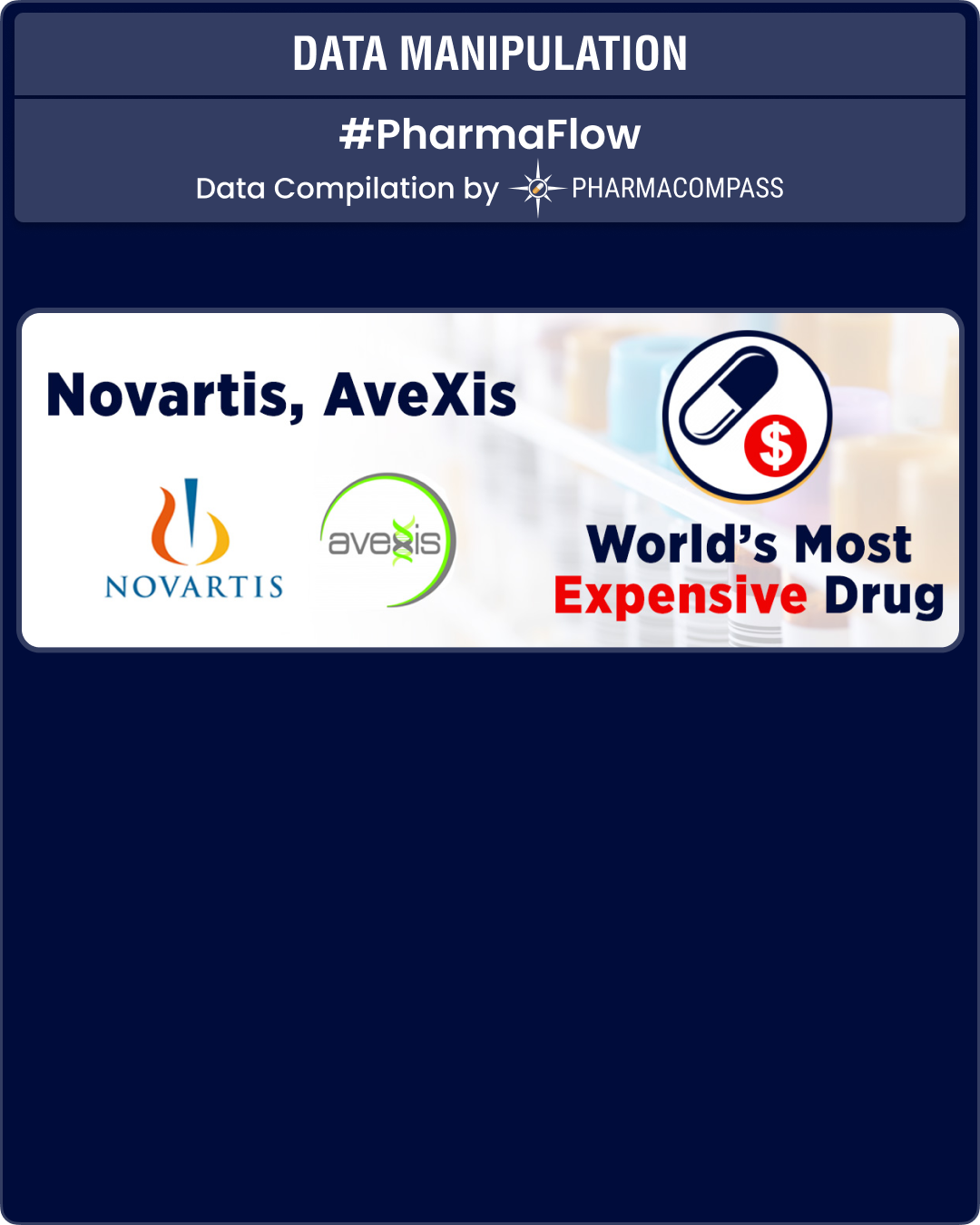
By PharmaCompass
2019-08-08
Impressions: 3600
Last week, Mylan and Pfizer had announced the merger of Upjohn, Pfizer’s off-patent branded and generic established medicines business with Mylan, to create a yet to be named new global pharmaceutical company. And PharmaCompass had carried an analysis on how the success of Mylan’s merger with Pfizer’s Upjohn will be determined by compliance.
Little did we know that our words would prove so foretelling. In a shocking announcement, the US Food and Drug Administration (FDA) issued a press release this week on the data accuracy issues with Novartis’ recently approved gene therapy — Zolgensma.
Zolgensma was acquired by Novartis in April last year when in a bid to secure its leadership position in gene therapy, Novartis struck a deal to acquire Illinois-based AveXis Inc for US$ 8.7 billion.
Zolgensma — world’s most expensive drug
The gene therapy, intended to treat children less than two years of age with the most severe form of spinal muscular atrophy (SMA), is priced at US$ 2.1 million, making it the world’s most expensive drug.
On May 24, the FDA approved Zolgensma. A month later, on June 28, the agency was informed by AveXis (the product's manufacturer) that its personnel had manipulated data from an in-vivo murine potency assay (SOP-285).
The FDA used this information to evaluate product comparability and nonclinical (animal) pharmacology as part of the biologics license application (BLA), which was submitted and reviewed by the FDA.
“It is the manufacturer's responsibility to submit complete and accurate information in marketing applications for evaluation by the FDA,” Peter Marks, director of FDA’s Center for Biologics Evaluation and Research, said in the statement.
Different manufacturing processes used in trials
According to information shared by the FDA, the product that was administered in the Phase 1 clinical trial was manufactured by a different process than the product that was administered in the Phase 3 clinical trial and the animal toxicology studies.
Because the manufacturing processes were different, interpretation of the overall clinical trial and nonclinical study results depends on understanding the characteristics of the Phase 1 version of the product in relationship to the characteristics of the Phase 3 version of the product. The data that were manipulated involve the results of an assay (SOP-285) that was critical in characterizing the comparability between the two versions of the product.
“If we become aware of a concern with data submitted to the agency as part of our review of a product application, it is in the best interest of patients, their caregivers, and the public that we disclose such information, to the extent permitted by law,” Marks added.
AveXis knew of data manipulation before BLA approval
AveXis’ investigation report reveals that the firm became aware of the data manipulation as early as March 14, 2019, more than two months prior to the BLA approval. However, AveXis did not inform the FDA of the issue until over a month after the BLA approval. If AveXis had informed FDA of this issue prior to the BLA approval, there was a possibility that the approval would have been delayed beyond the PDUFA goal date of May 31, 2019.
The FDA assessment states that although the BLA would have eventually been approved, it is carefully assessing this situation and remains confident that Zolgensma should remain on the market.
“Our concerns at this time are limited to only a small portion of the product testing data that was contained in the marketing application,” the statement said, adding that the “integrity of the product testing data used in the development of the product's manufacturing process is still a matter that we are continuing to evaluate and take very seriously.”
Novartis responds on data inaccuracies
Novartis issued a statement and also held a conference call over the matter. In the statement, the company said: “The data in question were a small portion of our overall submission and are limited to an older process no longer in use.”
CEO Vas Narasimhan said Novartis’ probe into the matter had two parts. The first concluded in early May and “confirmed discrepancies into the data and raised data integrity concerns”.
The next step was to launch the second part of the investigation, which was a “full technical quality investigation”. In the meantime, Zolgensma was approved on May 24. Narasimhan communicated the “initial findings” to the FDA on June 28, referring to its actions as “proactive” to ensure accurate data in the BLA.
“We are now in the process of exiting the small number of AveXis scientists involved in these data inaccuracies,” the CEO said.
A recent FDA inspection at AveXis’ control testing lab facility in San Diego had differing findings as the firm opened a non-conformance report on May 15, 2019, when the allegation was documented as having been reported on March 14, 2019.
The Form 483 issued after the inspection also states that after being informed about the data manipulation, the firm failed to conduct an “audit of all other potentially impacted data, studies and reports” to determine if there was “evidence of data mismanagement or manipulation”.
Our view
Mergers and acquisitions have gathered momentum in the world of pharmaceuticals over the last two years and pose an even greater onus on both parties to be more compliant insofar as data integrity and good manufacturing practices are concerned.
Surely, mega-mergers can transform the industry. But only if both the parties in question take compliance seriously and not as yet another mundane activity.
The PharmaCompass Newsletter – Sign Up, Stay Ahead
Feedback, help us to improve. Click here
Image Credit : Data Manipulation by PharmaCompass is licensed under CC BY 2.0
“ The article is based on the information available in public and which the author believes to be true. The author is not disseminating any information, which the author believes or knows, is confidential or in conflict with the privacy of any person. The views expressed or information supplied through this article is mere opinion and observation of the author. The author does not intend to defame, insult or, cause loss or damage to anyone, in any manner, through this article.”






